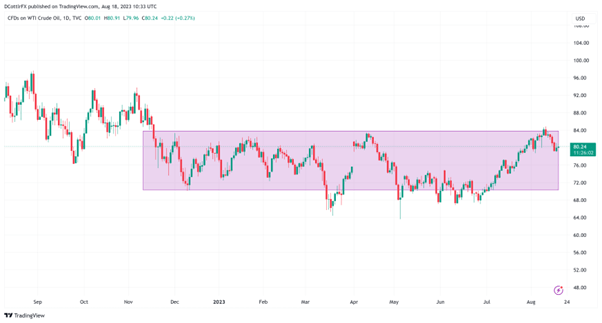US Crude Oil Weekly Forecast: China, US Demand Worries To Weigh

US Oil Price Forecast: Bearish Ahead
The winning streak of Crude Oil prices has been abruptly halted after seven weeks, as investors have shifted their attention from the absolute certainty of supply reduction to the potential decrease in energy demand.

In recent weeks, there has been a rise in concerning economic reports coming out of China, particularly highlighted by the alarming revelation that consumer prices have fallen significantly, leading to a state of deflation in the country. The struggles faced by China in its recovery from the Covid pandemic are further emphasized by the challenges being experienced within its immense real estate sector, with one of the major players, Country Garden, currently grappling with a severe debt crisis.
China is the leading global buyer of energy, so any indication that its economy is slowing down will always be concerning for those who are optimistic about the price of oil. What makes the situation even more troubling is that it appears China's economic troubles run deep, affect many areas, and are rooted in its structure, making it harder to find a fast solution. The government in Beijing has relaxed both monetary and fiscal restrictions, but analysts outside of China maintain a highly cautious stance when it comes to the country's prospects of achieving positive results in the near future.
Japan clearly does not serve as a precise comparison to China, but investors cannot ignore the fact that its efforts to revive domestic demand have been long and ineffective.
The oil industry is now also concerned about the United States. The recently published minutes from the Federal Reserve's meeting in July showed that the central bank is not confident enough to declare victory in the battle against inflation. They are well aware that interest rates could increase more than what the optimistic market had anticipated.
The notion that the United States' tightening of monetary policy was nearing its highest point undeniably bolstered oil prices. However, now it seems that reaching the peak will take a bit longer, and this has an anticipated impact on price levels.
Currently, the troublesome worldwide economy is controlling the oil market, overshadowing the impact of production decrease already implemented, and moreover, prolonged, by the Organization of Petroleum Exporting Countries (OPEC). In collaboration with Russia, they have lessened production by approximately one million barrels per day in this year, primarily aided by voluntary reductions from Saudi Arabia.
There isn't a lot happening on the economic schedule that will significantly impact the oil market in the upcoming week, so the prediction at the beginning of this page is pessimistic. We can expect to see inventory data from the US Energy Information Administration on Wednesday, and the heavyweight durable goods orders from the US the following day. While both of these reports may attract attention, it is unlikely that they will have long-lasting effects.
The unpredictable factor is the Jackson Hole conference of central bankers, which takes place in Wyoming and is organized by the Kansas City Fed. Jerome Powell caused significant disruption in global markets last year when he made a commitment to control inflation regardless of the difficulties it may bring. It is reasonable to assume that the markets will be interested to observe his next steps this year, including how it impacts the oil market.
Analysis Of US Crude Oil
Every day, a chart of the US WTI is created using the TradingView platform.
The daily chart of the West Texas Intermediate crude benchmark prevents a typical pattern of fluctuating significantly within a wide range, specifically between the bottom point on December 9 priced at $70.30 and the highest point on April 12 valued at $83.50, every time it moves outside of it.
It is possible that this is simply a longer period of slow trading in the Northern hemisphere during the summer months, and it is likely to change in the next few weeks. However, the market is clearly uneasy when it moves out of that range and is eager to return to it. It has mostly fallen below the lower limit, as it has been tested more frequently. The recent attempt to reach the top on August 9 was quickly rejected.
Currently, the market is dealing with strong backing within the trading range at $80 per barrel. If it falls below that level, attention will likely shift towards the peak of July 13 at $77.30. If buyers can establish a stable position above this threshold, it is quite possible that they will make another attempt at the $83.50 range. However, it would be a bold trader to expect the market to remain above that level for an extended period in the present circumstances.
IG's proprietary client sentiment indicator isn't particularly useful as it reveals traders are evenly split between optimism and pessimism, with a slight leaning towards the latter.
Discover More About IG Client Sentiment - Get the Complimentary Handbook Below.
--Authored by David Cottle, a contributor for DailyFX
DailyFX offers forex market news and technical analysis on the factors that impact the worldwide currency exchange markets.



























































